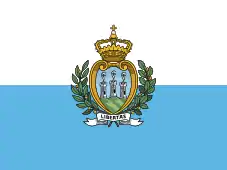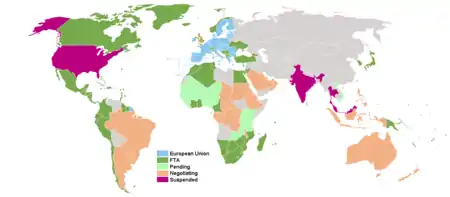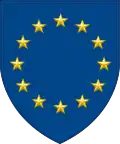Third-country economic relationships with the European Union
The European Union has a number of relationships with nations that are not formally part of the Union. According to the European Union's official site, and a statement by Commissioner Günter Verheugen, the aim is to have a ring of countries, sharing EU's democratic ideals and joining them in further integration without necessarily becoming full member states.
EFTA and EEA
The European Free Trade Association (EFTA) was created to allow European countries to partake in a free trade area with less integration as within the European Communities (later European Union). Most of the countries initially in EFTA have since joined the EU itself, so only four remain outside, Norway, Iceland, Liechtenstein and Switzerland.
The European Economic Area (EEA) agreement allows Norway, Iceland and Liechtenstein to have access to the EU single market. The four basic freedoms (goods, services, people and capital) apply. However, some restrictions on fisheries and agriculture take place.
Norway
Norway is a member of the EEA, therefore it participates in the single market, and most EU laws are made part of Norwegian law. Norway has signed the Schengen treaty, which means border checks are no longer made.
Iceland
Like Norway, Iceland joined the EEA, and is considered part of the EU single market. Iceland has also signed the Schengen treaty. On 16 July 2009, Iceland applied to join the European Union.
Liechtenstein
Liechtenstein joined the EEA in 1995 and participates in the EU single market.
Switzerland
The Swiss referendum to join the EEA in 1992 failed, so Swiss products do not participate in the European single market. However the country negotiated two series of bilateral agreements with the Union. The first series, Bilateral Agreements I, consists of seven bilateral agreements and was signed in 1999 (entry into force in 2001), the main part being Free Movement of Persons (full text of the agreement). The second series, Bilateral Agreements II, relates to nine areas and was signed in 2004 (entered into full force on 30 March 2005) and includes the Schengen treaty and the Dublin Convention (full text of the agreement) (official press release).
Eurozone-related
There are countries which, though not official members of the Eurozone, still use the euro as legal or de facto currency, through official agreements with the EU. These are European microstates which are largely economically dependent on their larger Eurozone-member neighbours.
 San Marino: San Marino is not a member of the EU, but had a special agreement with Italy to mint a limited number of Lira coins. With the passage to the Euro, the agreement was updated so that San Marino could mint specific Euro coins that can be used in all the Eurozone.
San Marino: San Marino is not a member of the EU, but had a special agreement with Italy to mint a limited number of Lira coins. With the passage to the Euro, the agreement was updated so that San Marino could mint specific Euro coins that can be used in all the Eurozone. Vatican City: The Vatican City State is not part of the EU, but like San Marino, there is an agreement to mint its own Euro coins (limited) which are legal tender in the Eurozone.
Vatican City: The Vatican City State is not part of the EU, but like San Marino, there is an agreement to mint its own Euro coins (limited) which are legal tender in the Eurozone. Monaco: Monaco is not a member of the EU, but French VAT applies. The Monegasque state had a special agreement with France (and now the EU) to mint its own Euro coinage, which is legal tender in all the Eurozone.
Monaco: Monaco is not a member of the EU, but French VAT applies. The Monegasque state had a special agreement with France (and now the EU) to mint its own Euro coinage, which is legal tender in all the Eurozone.
Some other countries unilaterally decided to use the Euro without having currently a formal agreement with the EU.
Customs unions
Certain countries are in customs union with the EU. These are:
 Turkey (excluding agricultural products; since 1996)
Turkey (excluding agricultural products; since 1996) Andorra (excluding agricultural products; since 1991)
Andorra (excluding agricultural products; since 1991) San Marino (signed in 1991 and in force since 2002)
San Marino (signed in 1991 and in force since 2002)
European Union free trade agreements

EU has concluded free trade agreements with many countries in the world, and negotiating with more through Stabilisation and Association Process, Association Agreements and Economic Partnership Agreements.
European Neighbourhood Policy

Covers Morocco, Algeria, Tunisia, Libya, Egypt, Jordan, Lebanon, Syria, Israel, Palestinian Authority, Moldova, Ukraine, Georgia, Armenia, Azerbaijan, Belarus, and Russia (through the formation of common spaces).
According to the European Union's official site, the objective of the European Neighbourhood Policy (ENP) is to share the benefits of the EU's 2004 enlargement with neighbouring countries. It is also designed to prevent the emergence of new dividing lines between the enlarged EU and its neighbours. The vision is that of a ring of countries, drawn into further integration, but without necessarily becoming full members of the European Union. The policy was first outlined by the European Commission in March 2003. The countries covered include all of the Mediterranean shores of Africa and Asia, as well as the European CIS states (with the exception of Russia and Kazakhstan) in the Caucasus and eastern Europe. Russia insisted on the creation of the four EU–Russia Common Spaces instead of ENP participation. Kazakhstan's Foreign Ministry has expressed interest in the ENP . Some MEPs also discussed Kazakhstan's inclusion in the ENP.[1]
The European Neighbourhood Instrument (ENI), came into force in 2014. It is the financial arm of the European Neighbourhood Policy, the EU's foreign policy towards its neighbours to the East and to the South. It has a budget of €15.4 billion and provides the bulk of funding through a number of programmes. The ENI, effective from 2014 to 2020, replaces the European Neighbourhood and Partnership Instrument – known as the ENPI.
The Euro-Mediterranean Partnership or Barcelona Process is a wide framework of political, economic and social relations between member states of the EU and countries of the Southern Mediterranean. It was initiated on 27–28 November 1995 through a conference of Ministers of Foreign Affairs, held in Barcelona. Besides the 27 member states of the European Union, the remaining "Mediterranean Partners" are all other Mediterranean countries without Libya (which has had 'observer status' since 1999). Since the establishment of the European Neighbourhood and Partnership Instrument in 2007 (see below) the Euro-Mediterranean Partnership initiative will become fully a part of the wider European Neighbourhood Policy. The Association Agreements signed with the Mediterranean states aim at establishing of a Euro-Mediterranean free trade area.
Financial cooperation and assistance programmes
CARDS programme
CARDS, short for "Community Assistance for Reconstruction, Development and Stabilisation", was established on 5 December 2000 through Council regulation Number 2666/2000.
Its scope is the Western Balkans countries (Albania, Bosnia and Herzegovina, Kosovo, Macedonia, Montenegro and Serbia). The programme's wider objective is to support those nations in the Stabilisation and Association Process.
TACIS programme
The TACIS programme, established in 1991, was a programme of technical assistance that supports the process of transition to market economies for the 11 CIS countries and Georgia. Until 2003, Mongolia was also included in the programme but is now covered by the ALA programme.
MEDA programme
The MEDA programme was the principal financial instrument for the implementation of the Euro-Mediterranean Partnership, offering technical and financial support measures to accompany the reform of economic and social structures in the Mediterranean partner countries.
The first MEDA programme was established for the period of 1995–1999. In November 2000, a new regulation established MEDA II for the period of 2000–2006.
ACP programme
ACP stands for "Africa, Caribbean and Pacific". The programme applies to 71 countries, among which are all African nations with the exception of the Mediterranean countries of northern Africa (covered by the MEDA programme above). The ACP is currently covered by the Cotonou Agreement, which replaces the Lomé Convention.
External links: ACP Countries at official EU site
ALA programme
ALA, standing for "Asia and Latin America" is a programme for financial aid and cooperation with those regions.
For the 2007–2013 budgetary period
- ENPI, standing for "European Neighbourhood and Partnership Instrument". This is a financial instrument that covers the ENP countries. Russia is also covered by ENPI (it chose not to participate in the European Neighbourhood Policy (ENP) and opted for the formally different, but practically similar EU–Russia Common Spaces. Because of this is the "Partnership" part of ENPI). ENPI therefore merges the former MEDA (as all of its current beneficiaries are ENP states) and the European part of the former TACIS structure.[2] The ENPI Info Centre was launched in January 2009 by the European Commission to highlight the relationship between the EU and its Neighbours.
- The Pre Accession Instrument replaces the former Enlargement programmes Phare, SAPARD and ISPA and CARDS (current CARDS beneficent states were moved to the Enlargement policy segment as "potential candidate countries").
- The Development Cooperation and Economic Cooperation Instrument covers all countries, territories and regions that are not eligible for assistance under either the PAI or ENPI (Asia, including Central Asia, Latin America, Africa, Caribbean and Pacific). Thus it will replace ALA, ACP and the rest of TACIS.
- Horizontal instruments, that cover countries regardless of their region, are:
- the Instrument for Stability, a new instrument to tackle crises and instability in third countries and address trans-border challenges including nuclear safety and non-proliferation, the fight against trafficking, organised crime and terrorism.
- Food aid is added to the Humanitarian Aid instrument.
- the Macro Financial Assistance will remain unchanged.
Economic variation
Below is a table and three graphs showing, respectively, the GDP (PPP), the GDP (PPP) per capita and the GDP (nominal) per capita for some of the third countries that the European Union has relations with. This can be used as a rough gauge to the relative standards of living among member states.
The table is sorted by GDP (PPP) per capita to show the relative economic development level of the different countries. Reference values for the EU average, highest and lowest are included.
| Third country | GDP (PPP) millions of int. dollars |
GDP (PPP) per capita int. dollars |
GDP (nominal) per capita int. dollars |
|---|---|---|---|
| European Economic Area: | |||
| 38,808 | 78,395 | 104,512 | |
| 14,793,000 | 29,729 | 33,052 | |
| 90,869 | 12,067 | 6,722 | |
| 12,148 | 38,022 | 37,976 | |
| 4,160 | 122,100 | 113,210 | |
| 259,054 | 52,964 | 88,590 | |
| European Free Trade Association: | |||
| 314,869 | 43,007 | 69,838 | |
| European Microstates: | |||
unique noncommercial economy |
252 | 273,615 | no data |
| 1,170 | 35,928 | 44,208 | |
| 4,888 | 65,928 | 88,761 | |
| 4,220 | 44,900 | 34,240 | |
| Current Enlargement Agenda: | |||
| 40,151 | 13,991 | 5,373 | |
| 49,794 | 14,220 | 5,742 | |
| 23,524 | 13,017 | 4,649 | |
| 12,516 | 20,074 | 8,749 | |
| 34,267 | 16,486 | 6,096 | |
| 137,126 | 19,767 | 7,992 | |
| 2,346,000 | 28,264 | 8,958 | |
| European Neighbourhood Policy: | |||
| 158,350 | 23,416 | 18,266 | |
| 67,244 | 11,630 | 6,699 | |
| 1,575,561 | 11,041 | 5,369 | |
| 83,673 | 8,255 | 2,978 | |
| 75,217 | 7,711 | 3,031 | |
| 237,684 | 7,189 | 3,086 | |
| 338,486 | 7,156 | 1,727 | |
| 24,420 | 6,681 | 6,033 | |
| 27,960 | 4,825 | 2,219 | |
| 38,708 | 4,601 | 1,493 | |
| 135,742 | 4,503 | 1,725 | |
| 305,255 | 4,317 | 1,316 | |
| 14,167 | 4,270 | 1,137 | |
| 71,736 | 3,847 | 1,418 | |
| 15,498 | 3,616 | 1,493 | |
| 8,563 | 2,374 | 825 | |
| 2,568 | 660 | no data | |
Source: CIA World Factbook , IMF
See also
- List of the largest trading partners of the European Union
- European Association for Evolutionary and Political Economy
- European Union Association Agreement
- European Union free trade agreements
- EU-Russia Common Spaces
- Free trade areas in Europe
- Special member state territories and the European Union
- Yugoslavia and the European Economic Community
- Southeast Europe Transport Community
- EU Neighbourhood Info Centre
- EU Neighbourhood Library
